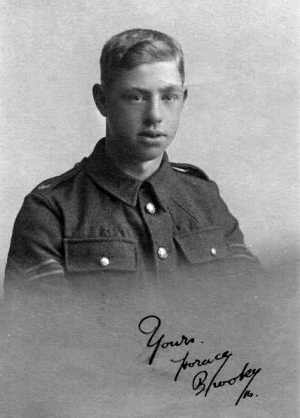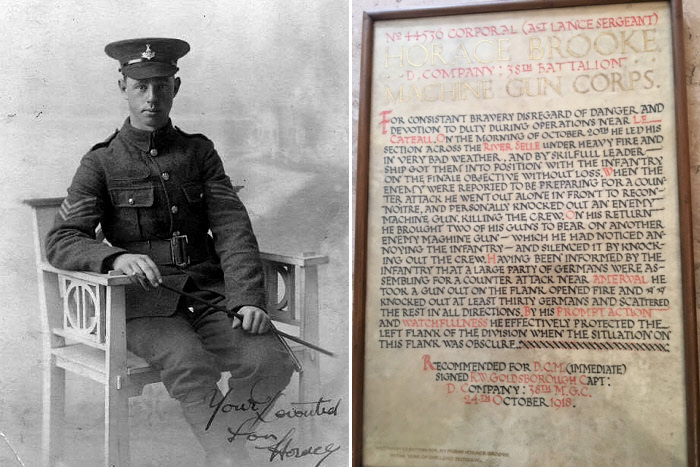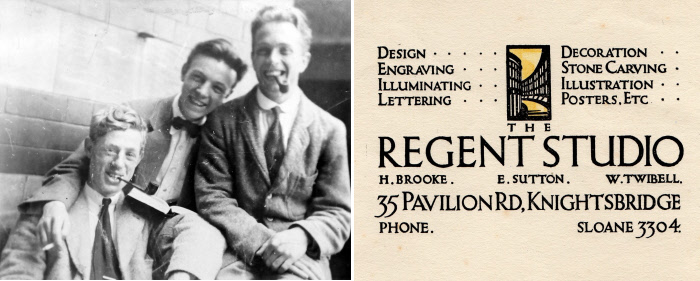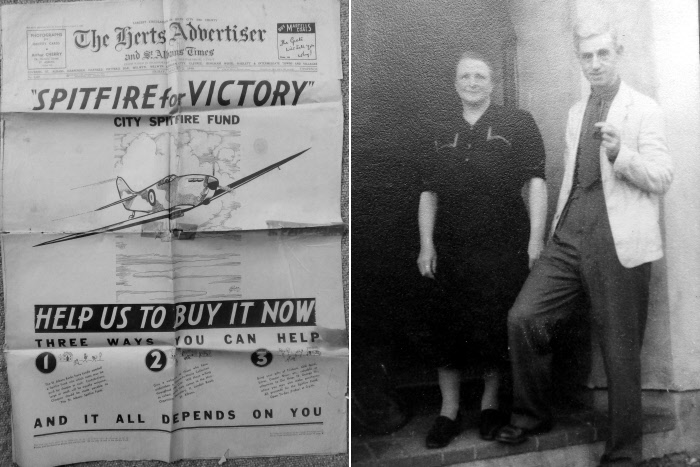
Horace Brooke was born on the 11th April 1898, the second son of Lionel and Mary Brooke. Sadly, his older brother, Leonard Brooke was killed in France in February 1917. Horace had a sister Ada and three more brothers, Albert, Ernest and Gilbert. The family lived on Cross Street, Gawthorpe and later they moved to High Street. Lionel ran a milk round. The family were active members of the Bethesda Methodist Church in the village and the children attended the village school.
Horace showed an early aptitude for art and he was taken under the wing of local artist Arthur Oldroyd. Wilfred Gledhill was his teacher when he attended the Ossett Municipal Technical School as a part-time student between 1910 and 1913, he appears to have also have been working as a farm hand during this period.
Between 1913 and 1915 Horace attended Leeds School of Art, but his studies were interrupted when he enlisted in the Green Howards at Richmond on the 18 November 1915. Fortunately, his service papers survive and, although his age is wrongly recorded as 19 years and 7 months.
Horace had a rather up and down career in the army. On the 8th June 1916 he was promoted to Corporal, two weeks later he was a Sergeant. He transferred to the Machine Gun Corps the following month. However, the following year, in March, he was tried in Aldershot for “neglecting company orders” and “conduct to the prejudice of good order and military discipline” and was found guilty – the sentence was a demotion to Corporal. But Horace bounced back with a promotion to acting sergeant on the 23rd October 1918 and the following week to full sergeant. These promotions were undoubtedly related to the acts of bravery that won him the Distinguished Conduct Medal. It is worth reproducing the citation in full:
“For consistent bravery disregard of danger and devotion to duty during operations near Le Cateau. On the morning of October 20th he led his section across the River Selle under heavy fire and in very bad weather, and by skillfull [sic] leadership got them into position with the infantry on the final objective without loss. When the enemy were reported to be preparing for a counter attack he went out alone in front to reconnoitre, and personally knocked out an enemy machine gun killing the crew. On his return he brought two of his guns to bear on another enemy machine gun – which he had noticed annoying the infantry – and silenced it by knocking out the crew. Having been informed by the infantry that a large party of Germans were assembling for a counter attack near Amerval he took a gun out on the flank opened fire and scattered the rest in all directions. By his prompt action and watchfullness he effectively protected the left flank of the division when the situation on this flank was obscure.
Recommended for D.C.M. (immediate) signed by R W Goldsborough Capt: D Company: 38th M.G.C. 24th October 1918″.
The Battle of the Selle, 17th – 25th October 1918, saw the British force the Germans out of a new defensive line along the River Selle that they had been forced to take up after being forced out of the Hindenburg Line. The Allied advance had been slowed in the face of increasing German resistance, and by the 10th October the Germans were taking up a new position on the River Selle, close to Le Cateau. The British needed two weeks to prepare to attack the new position. Cambrai-St. Quentin had been a costly battle and the British had suffered 140,000 casualties during the battle, so needed time to reorganise and to bring up their artillery.

Above: Sergeant Horace Brooke, DCM with a framed copy of his medal citation.
On 17 October Rawlinson’s Fourth Army attacked on a ten mile front south of Le Cateau. Their aim was to reach a line between Valenciennes and the Sambre and Oise Canal. From there the key German railway centre at Aulnoye would be in artillery range. The Fourth Army attack made slow progress – after two days the right wing had made the biggest advance, a move of five miles. The attack was then widened.
By the evening of the 19th October, the First Army (Horne) had fought its way into a position where it could take part in an attack north of Le Cateau. Early on the morning of the 20th October the First and Third Armies attacked north of Le Cateau. By the end of the day they had advanced two miles. In earlier battles that would have been a dangerous distance to have moved, and would have placed the British right in the middle of the German fighting zone, but the fighting had moved out of the German fortified zone and into open country, and the Germans had only had ten days to build up their defences on the Selle.

Above: British troops resting on a felled tree near Le Cateau, October 25th 1918.
On being demobbed in February 1919, he returned to Leeds School of Art where he studied for the next two years. In 1921 Horace was awarded a County Art Scholarship in 1921 to attend the Royal College of Art (RCA) in London.
When Horace left the RCA in July 1925 he set up a design business with fellow RCA students, E. Sutton and W. Twibell. The business was known as The Regent Studio and was based in Knightsbridge and the trio focused on “Design, engraving, illuminating, lettering, decoration, stone carving, illustrations, posters etc.”

Above: Horace Brooke (left), it is thought with with E. Sutton and W. Twibell, founders of The Regent Studio, Knightsbridge, London in 1925.
It’s not clear when Horace ventured out on his own, but by 1931 he had established himself as a commercial artist in St Albans. On the 14th August 1923, Horace of 18, High Street, Gawthorpe married his long-time sweetheart, Dewsbury girl Elsie Evelyn Lovell at the Bethesda Chapel in Gawthorpe. In 1924 Elsie gave birth to their son Howard.

Above Left: Horace Brooke’s wife Elsie Lovell and right: Horace Brooke in his WW2 RAF uniform.
Like all commercial artists, Horace worked on a mixed range of projects for a varied array of clients. During the Second World War Horace served his country again and also produced drawings for the local paper to promote the purchase of a Spitfire on the front cover of The Herts Advertiser in August 1940.
After retirement, Horace and Elsie returned to their beloved Yorkshire and he taught art at Heckmondwike Senior School before opening a sweet shop at Daisy Hill, Dewsbury. Elsie died in 1958 followed seven years later by Horace, who died on the 25th January 1965.

Above Left: The Spitfire Fund drawing by Horace Brooke in the Herts Advertiser and right: Horace Brooke with his wife Elsie in the 1950s.
The stories of Horace and his brother Leonard Brooke illustrate the contrasting fates of two soldiers who fought in the First World War, Leonard cut down in his prime at the age of twenty-one and Horace who went on to marry, have a family and enjoy a successful career building on his artistic aptitude.
This story of Horace Brooke is courtesy of Dr Christine Boydell.
Here is a link to Christine’s Blog Festival of Pattern with further details and many more pictures covering Horace Brooke’s life as a Commercial Artist.
Acknowledgements
Most of the images in this article are owned by the family, particular thanks to Jacqueline Smith (Horace’s granddaughter), Mary Clay (Horace’s niece) and Andrew Clay (Horace’s great nephew). Thanks also to Neil Parkinson (RCA), Kate Gilliland (Leeds College of Art) and Keith Rowntree (Leeds Beckett University).
Christine Boydell is the partner of Andrew Clay.